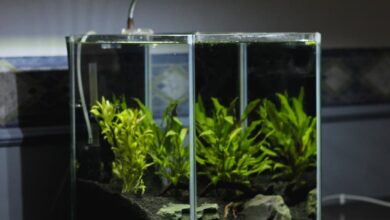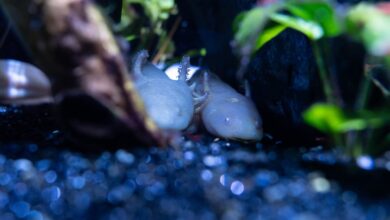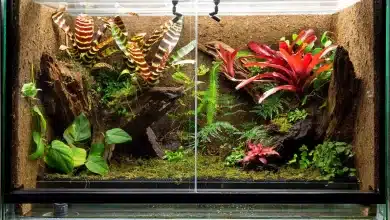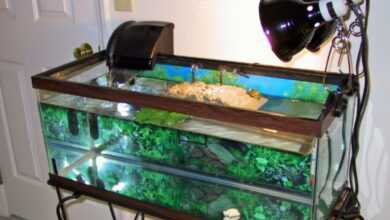Best 3 Gallon Fish Tanks – Equipment, Stocking and Setups
It can be difficult to choose the right fish tank from the many options available. The first thing you need to ask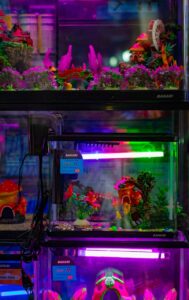
The 3-gallon tank has the advantage of being one of the smaller tanks available. It’s also cheap, and should fit anywhere.
They do come with challenges, like fitting everything in. They can be used for more than just holding a few small fish.
This guide will show you how to stock your tank, set it up and more.
Table of Contents
Toggle3 Gallon Fish Tanks 101 (Overview)
The bigger the aquarium, the healthier the fish. A 3-gallon aquarium can cause problems because it is so small.
In a 3 gallon aquarium, you can keep a few fish.
Most new fish keepers believe that a small tank is easier to maintain and care for. This is not the case.
In smaller tanks, pollutants can quickly accumulate because the volume of water is less. It will take more time and effort to keep the tank and water clean.
The dimensions of a typical tank will be 12″ x 6″ x 8″. The tank will weigh approximately 3lb empty and 27lb full. However, these numbers may vary between tanks.
The aquarium is small, light and can be placed on any surface. However, it must be large enough to hold the water and decorations when filled.
3 Gallon Fish Tank Equipment
It’s not just a matter of filling the tank with water and adding fish. There are many other things to consider.
You can buy a tank as part of a set that includes everything you need for it to run. It’s not always the case.
This is the list of equipment that you will require:
Best 3 Gallon Fish Tanks Filter
If you want a tank to be healthy, it isn’t complete with out a filter. It is the most crucial aspect of any aquarium, as it cleans the water.
As water passes through a filter, it removes harmful chemicals, waste, and excess food.
It is important to do this for a tank that holds only 3 gallons of water. A filtration system that is effective will help to prevent pollutants from building up quickly.
The water is drawn into the tank at the inlet and then passed through the filter media. Replace the filter media every two months to ensure that everything is running smoothly.
Best 3 Gallon Fish Tanks Heater
Not every tank will require a heater. These heaters should only be used in tanks with fish from warm water. It is common to include tropical and marine fish in this setup, but for a small tank, a marine set-up would not be an option.
You will need to heat the water within a specific range for your tropical fish. You will need to research the best temperature for each species.
There are many different sizes of heaters. The larger ones are used for large tanks, as they must be stronger to heat all the water. A small heater is needed for a 3-gallon container.
The heater will range between 10 and 15 watts.
Best 3 Gallon Fish Tanks Lights
The majority of species require a source for day and night. Light is essential for photosynthesis.
You can buy bulbs that produce different light intensities. You must do your research to ensure that the light bulb you purchase is safe for the fish in your aquarium.
Other Equipment
This size tank is usually not supplied with a stand, as it can be placed on almost any surface. You will need to find a surface that is larger than the bottom of your tank, and which can hold its weight with water.
It is also important to have a hood that fits snugly, as this will prevent fish from jumping out of the top.
Substrate should be applied to the bottom of your tank in a thickness of 1 inch. Gravel works well, but some fish that live at the bottom of the tank may prefer sand.
Then you can place some decorations over the substrate. If you don’t have a lot of space, it’s best to leave the majority of the substrate empty so that the fish can swim.
The thermometer can be used to check the temperature. The best way to estimate the temperature of water is by placing it opposite the heater.
Cleansing equipment, such as algae magnets and vacuums for gravel, is useful when cleaning. The easiest way to transfer fish between tanks is with a fish net. The water you pour into your aquarium must first be treated with de-chlorinator to remove any toxic chlorine.
Review of the Best 3 Gallon Aquariums
3 Gallon Starter Kit
Tetra LED Betta Tank
This tank is perfect for beginners and experts. It’s ideal for tropical fish.
This Tetra Aquarium is a great starter tank for students, children, families and offices.
The tank comes with a Whisper Power Filter and Cartridge, a pedestal to rest it on and LED Lighting.
The cube tank is stylish and sleek, giving a 360-degree view of all the fish.
The tank and cover are both made of durable plastic, which is resistant to shattering and cracking. This makes it perfect for families and children.
Good:
- You can change the flow rate of the filter.
- This is an excellent nano tank.
- The tank has a very small footprint and can be used anywhere.
- A great value starter kit.
Bad:
- If you want tropical fish, a heater is required.
- It takes some time for the filter to function efficiently.
- Acrylic is a material that can easily scratch.
The Best 3 Gallon Fish Tank
MarineLand Aquarium Kit
This elegant aquarium is great for beginners as well as advanced aquarists.
The MarineLand glass tank is unique, cube-shaped and has a rail lighting across the top. Lighting has two LED settings: moonlight and daylight. The white light creates a sun-like glow on the water, while the blue light gives off a moonlight glow.
The tank has either a sliding or hinged glass canopy that allows you to get into the tank and feed your fish. This tank has a hidden three-stage filtration system with an adjustable flow rate.
The company who created this aquarium is well-known for its excellent customer service and is known as one of the best in the industry.
Good:
- The tank is very easy to maintain and clean.
- The filter’s flow rate can be adjusted.
- LED lights can be set to two different settings: daylight and moonlight.
- Secure lid.
Bad:
- Plants that require lots of light will not thrive in this lighting.
- The back plastic section cannot be heated.
- The filter may be too strong for certain fish (e.g. a Betta).
Beginner 3 Gallon Fish Tank
GloFish Aquarium
This 3-gallon tank would be perfect for a beginner or as a child’s first aquarium.
This tank is ideal for beginners or children’s first tanks. This tank will fit in any small area, like a child’s room or an office desk.
The unique white and blue lights will bring out the true colors of any fish that you choose to keep.
The tank is equipped with a Whisper Filter that keeps your water clean and very quiet. The aquarium comes with a cover and an internal filter, as well as a medium cartridge.
Good:
- The instructions are easy to understand.
- This is a great book for beginners.
- The lights are bright.
- The tank offers good value for the money.
- The filter’s flow rate can be adjusted.
Bad:
- If you keep tropical fish, you will need to purchase a heater.
- The lid does not attach securely to the tank.
- It is acrylic rather than glass.
Best Value 3 Gallon Aquarium
Koller 3 Gallon Aquaview Tank
This tank is easy to install and comes in a cylindrical shape. It’s made from one piece of durable plastic.
The material and shape of this tank make it ideal for a first tank.
The tank is shaped like a cylinder so there’s no risk of hitting a sharp edge. Materials used are strong and durable. The unit is easy to install and includes energy-efficient LEDS. It also comes with a timer.
The aquarium is equipped with an internal water filter which cleans 25 gallons of water per hour.
Good:
- Unique style, one-of-a-kind.
- Ideal for families with young children.
- The price is reasonable.
- Simple to clean and maintain.
Bad:
- The cylindrical shape is difficult to decorate.
- Batteries are required for the lights.
- This is not ideal for fish who need horizontal space to swim.
3 Gallon Fish Tank For Betta
Cobalt Aquatics Microvue
This glass aquarium will be perfect for you if your goal is to get a Betta starter kit of high quality.
The Cobalt Aquatics Microvue is a stylish, modern fish tank perfect for those who are new to fishkeeping.
This triangular tank will be the focal point wherever you place it. From a kitchen counter to your office desk, this tank has a unique shape.
The unit comes with soft-white LED lights that are hidden, as well as an internal filter preloaded with carbon.
As your Betta grows, you will need to transfer them to a 5-gallon aquarium.
Good:
- The LED lights are very bright.
- Tank is affordable, and of good quality.
- The small footprint makes it ideal for small spaces.
- It is easy to change the filter media.
Bad:
- It’s not a very powerful filter, but is perfect for a small tank.
- If you plan to keep tropical fish, you will need a heater.
- Some areas of the top are hard to clean.
Best Fish For 3 Gallon Tanks
Fishkeeping is a vast field, and there are many species to choose from. However, only a few can fit in a 3 gallon tank.
If your fish are too big, they may become stressed or even sick . It’s also unlikely that you can fit many fish in the tank, since each one needs its own space.
You can also consider juveniles. You can get them in a smaller tank, but as they grow you’ll need to upgrade to a larger one to avoid overcrowding.
Here are some options for a tank this size.
- Otocinclus- This little bottom-dweller helps to clean your aquarium by eating algae off surfaces.
- Guppies- They are available in a variety of colors and can brighten any aquarium.
- Neon Tetras This is one the most iconic aquarium fish species. They group together to produce bright colors.
- Zebra Danios This species is hardy and great for beginners.
- Bettas: These must be kept in a separate aquarium. They are not only aggressive but also larger than other options.
All these species require larger tanks for healthy growth, so they should be moved when they reach maturity.
Invertebrates can be kept in a 3 gallon aquarium. They will actually be more comfortable because they won’t move as much.
You can keep dwarf shrimp in groups as small as 5-8. You can keep small snails in the same numbers, such as ramshorns.
3 Gallon Aquarium Ideas
Fish tanks have many functions. A 3 gallon aquarium is too small to accommodate most fish. However, a tank of this size can be used for other purposes.
1. Nano Tank
There is no specific definition, but in general nano tanks are less than 10 gallons.
In a nano-sized tank, only small fish will fit. You can’t have many. You can only keep one Betta in a 3 gallon nano tank.
2. Quarantine tank
In some tanks, disease can become a major problem. It is possible for an outbreak to spread quickly among all of your fish.
Early detection of symptoms is crucial. You should move your sick fish to the 3-gallon aquarium if you suspect it. This tank becomes a quarantine. This is done to prevent the infected fish from spreading disease. Once the fish has recovered, you can put it back in its original tank.
You can also find out more about the following:
If you’re unsure about the health status of your fish, quarantining them before adding them to your main aquarium is a better option.
3. Breeding Tank
The fish are still small enough in 3 gallons to make them comfortable.
You can place your pregnant fish in the 3-gallon aquarium until they give birth. Once the juveniles have outgrown their tank, they will need to move.
4. Feeder Fish
Live foods can be a good option when it comes to feeding. You can grow your own live food in a 3-gallon aquarium.
Feeder fish is a small species bred for feeding your larger fish. You can start them off in a 3-gallon aquarium and then transfer them to the main tank.
5. Paludarium
Explore the world of plants by trying out a paludarium. You can remove the fish from the aquarium and replace it with dense plants. It is important to consider the space requirements for your plants. If they are too close together, they will compete against each other.
FAQs
How many fish can I keep in a 3 gallon tank?
It will depend on what species you plan to keep. The space is limited, so the number of fish will be small. You will be limited to keeping Bettas alone.
You can group them together in a large enough group to accommodate the shoaling species. They also need plenty of space for swimming.
What is the best 3 gallon tank to use?
The tank is too small for fish to stay in. The tank is usually too small to allow for enough swimming room. Some species may outgrow it as they grow.
You can still use it in other ways. Three gallons are enough to use as a quarantine, breeding or feeder tank.
You can read more about it here:
You should choose the biggest aquarium you can fit or afford. It is easier to maintain a larger tank, and you have more options when it comes to filling it.
A 3 gallon aquarium is one of the most compact tanks on the market. It’s best to use it when you only plan to keep fish in the tank for a brief period.
You may need a safe place to give birth for your fish if they keep getting pregnant. You may need to isolate a sick fish to protect others. These roles can be filled by a 3 gallon aquarium.
You should consider both your own needs and those of your fish before purchasing.

